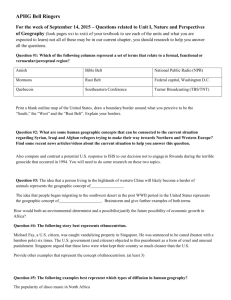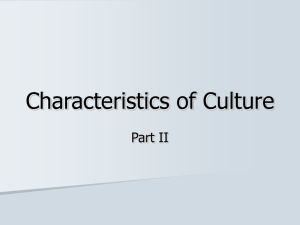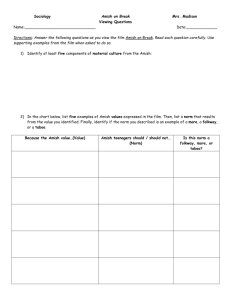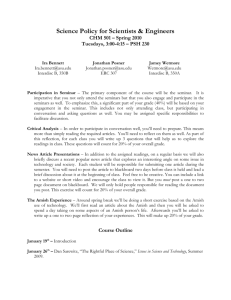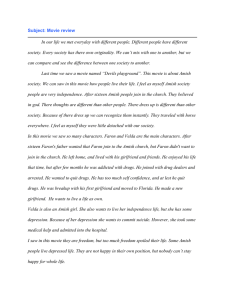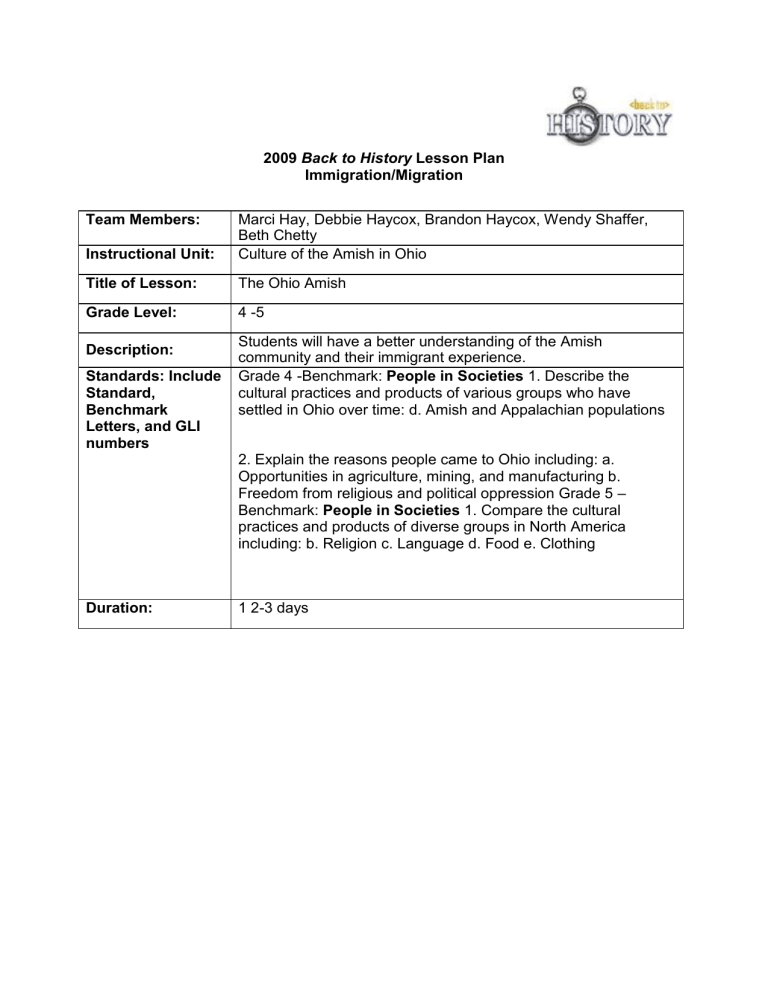
2009 Back to History Lesson Plan
Immigration/Migration
Team Members:
Instructional Unit:
Marci Hay, Debbie Haycox, Brandon Haycox, Wendy Shaffer,
Beth Chetty
Culture of the Amish in Ohio
Title of Lesson:
The Ohio Amish
Grade Level:
4 -5
Description:
Standards: Include
Standard,
Benchmark
Letters, and GLI
numbers
Students will have a better understanding of the Amish
community and their immigrant experience.
Grade 4 -Benchmark: People in Societies 1. Describe the
cultural practices and products of various groups who have
settled in Ohio over time: d. Amish and Appalachian populations
2. Explain the reasons people came to Ohio including: a.
Opportunities in agriculture, mining, and manufacturing b.
Freedom from religious and political oppression Grade 5 –
Benchmark: People in Societies 1. Compare the cultural
practices and products of diverse groups in North America
including: b. Religion c. Language d. Food e. Clothing
Duration:
1 2-3 days
iawlso aCnodluR
• MaterT
menso
Cuhracre
t s:
Map A: Amish Communities in Ohio
•
Worksheet A – Amish in Ohio
•
Worksheet B – Get to the Source with Music
•
Worksheet B – Get to the Source with Photographs
•
“The Amish Immigrant Experience in Ohio.”
•
•
Think TV Resource
http://www.thinktv.org/education/k-12-multimedia-resources/our-ohio-exploringour-heritage/
Primary Source Materials:
Amish Song – Ausbund (Amish hymn book) – Worksheet B – Get to the Source
with Music.http://www.thinktv.org/education/k-12-multimedia-resources/our-ohioexploring-our-heritage/
•
Amish Pictures – Get to the Source with Photographs (Library of Congress
American Memory “America from the Great Depression to World War II: Black and
White Photographs from the FSA_OWI, 1935-1945,”
http://www.loc.gov/pictures/collection/fsa/ )
•
The Amish Immigrant Experience in Ohio – Created by Marci Hay, Debbie
Haycox, Brandon Haycox, Beth Chetty, and Wendy Shaffer
•
Warm Up:
1) Write the word “Amish” on the board. Ask students what images come into their mind
when they read the word Amish. Write these ideas or images on a concept map.
2) Write the word “immigrant” on the board; explain to the class that immigrants are people
who come to a new country to live. Ask students what reasons people might have for
leaving their home to travel hundreds or even thousands of miles to come and live in a
totally new place. (Exploring Our Heritage: The Ohio Amish) 3) Make sure students know
the Amish came to America to find religious freedom and for the opportunity to farm land. 4)
Show the teacher created DVD – “The Amish Immigrant Experience in Ohio.”
Instructional Strategies:
Day One – Get to the Source with Music
1) Ask students how immigrants preserve their heritage from their homeland. Write
their responses on the board. The Amish have preserved their culture by isolating
themselves from others.
2) One way the Amish preserve their heritage is by handing down hymns or religious
music from their homeland. Pass out Worksheet B – Get to the Source with Music.
Students will read the hymn aloud as a class. After reading the song, have the students
chant the song and then try to sing it to the tune of “Mary had a Little Lamb.”
3) Discuss how the mood of the song changed from the first reading to the second.
4) Students will answer the questions at the bottom of Worksheet B.
Day Two – Get to the Source with Photographs.
1) Remind students how primary source photographs can provide information about
the past. Review beliefs from yesterday’s discussion.
2) Pass out primary source photographs. Divide students into groups of 2 or 3 to
analyze the photographs.
3) Students will answer the questions on Worksheet B regarding the photographs.
Homework / Practice:
1) Students will use Map A to identify Amish communities in Ohio and be able to use the
map to answer questions on Worksheet A.
Assessment Question:
After watching “The Amish Immigrant Experience in Ohio”, students should realize that
Amish communities differ from their own. Explain to students that they, too, live in a
community, and that all communities are special in their own way. Distribute the Two
Column Chart, and students will make 2 comparisons and 2 contrasts between the
Amish communities and their own.
4 – Students will correctly identify 2 similarities and 2 differences between the Amish
community and their own.
3 – Students will correctly have a combination of 3 similarities and/or differences
between the Amish community and their own.
2 - Students will correctly have a combination of 2 similarities and/or differences
between the Amish community and their own.
1 – Students will correctly have 1 similarities and/or differences between the Amish
community and their own.
0 – The response does not meet the criteria required to earn one point. The response
indicates inadequate or no understanding of the task and/or the idea or concept needed
to answer the item. It may only repeat information given in the test item. The response
may provide an incorrect consequence. The student may have written on a different
topic or written, “I don’t know.”
Extension Activity: (Choose 1)
Option 1:
Pass out a different piece of quilting material to each student. Each student will create a
quilt section relating to the Amish lifestyle. As a class we will recreate a quilting bee to
sew our class quilt. Upon completion of the quilt, the students will share what their quilt
section depicts, and how it relates to the Amish lifestyle. The quilt will be displayed in
the hallway.
Option 2:
Students will create a PowerPoint presentation which reflects their knowledge
regarding the Amish immigrant experience. Upon completion students will share
their presentations with the class.
Name:
Two-Column Chart
Directions: When comparing our community to the Amish community,
identify at least 2 similarities and 2 differences between the two
communities.
Bibliography
Beachy, Leroy, and Stanley Kaufman. Amish in Eastern Ohio. Walnut Creek:
German Culture Museum, 1991.
Library of Congress. 2009. “Amish Photographs.”
http://memory.loc.gov/ammem/fsowhome.html
Miller, Levi. Our People: The Amish and Mennonites of Ohio. Scottsdale, Pa:
Herald Press, 1983.
Ohio Pix. 2009. Ohio Historical Society. Photograph numbers: AL03303, AL03302,
AL02711. ohiopix.org
Amish History Is A story of Struggle and Faith
http://www.exploring-amish-country.com/amish-history.html
Think Education. 2009. “Exploring Our Heritage: The Ohio Amish.” Think TV Network.
June 23, 2009. http://www.thinktv.org/education/k-12-multimedia-resources/our-ohioexploring-our-heritage/
THE OHIO AMISH
MAP A: Amish Communities in Ohio
Totedo
(Ohio Department of j ob and Fam ily Services}
Exploring Our I terilage - The Ohio Amish 7
THE OHIO AMISH
WORKSHEET B:
Get to the Source with Photographs
The Amlsh believe in a simple way of life and do not use electrlclty, watch tetevlslon, or drive automobiles.
7hey also dress In plain, slmpte, clothes and do not approve of having thelr photographs taken for reltglous
reasons, especially their faces. However. some Amish are stricter than others. DiPerent groups ofAmish
dlPer slightly In their beliefs.
Retires and photographs can tell us many things about the past and the world around us. Below are
two pictures of Amish people taken fifty years ago. Look closely at both pictures to answer the questions on
11.
{Photos courtesy ofThe tlbrary of Congress)
10
zxn/a»ng
Hen&ge - The Ohio Amlsh
■
Kxplorlng Our heritage
■
THE OHIO AMISH
WORKSHEET B:
Get to the Source with Photographs continued
DATE:
NAME:
Look at the photo on the left. What does the Amish man in the photo appear to be doing?
2. Is there anything in the photo you would not expect to find in an Amish home or building?
What reason might there be for its presence?
3. Based on your knowledge of Amish beliefs, is there something that surprised you about
the man in the picture?
Look at the photo on the right. What types of stores can you identify from the picture?
Based on what you see in the photo, how did most people travel to these stores*
6. Find the Amish man and woman in the photo. How do you think they traveled to the store?
7. To which store would the man and woman likely NOT be going?
8. What might be a good reason for the photographer taking the photo of the Arnish man and woman
from behind?
9. This photograph was taken in tpgg. Do you think the Amish man and woman would be dressed any
differently in zoo6?
Why do you think the man and woman have come to the town?
’
t‘!
Find the original document at: http•/ /memory.toe.gov/ ammea /fsow'home.htmt
Exploring [|r heritage - The Ohio Amish 11
Exploring Our Heritage
THE OHIO AMISH
WORKSHEET B
Get to the Source with Music
NAME:
DATE:
Music and songs are another type of primary source. They can tell us many things about a culture.
Singing songs is one way Amish parents teach their children their beliefs. From nursery rhymes to religious
hymns, music is important to Amish life.
Religious music is very important to the Amish. The Amish still sing songs from a hymn book called the
Ausbund which is over five hundred years old. Below is a song from the Ausbund that is still sung by the
Amish today. Think about the meaning of the song, and also use your knowledge about the Amish to help
answer the questions.
"Es sind zween Weg™
Es sind zween weg in dieser Zeit,
Der ein ist schmol, der onder welt,
Wer Jetzt will gehn die schmole Bohn,
Der wird verocht von teder monn.
°There ore Two Ways"
There ore two ways in this our day,
One narrow, and the other brood,
Who will go the notrow path,
Will be despised by all aboard.
(Phonetic pronunciation)
S zint zveen veg in deez air Zite
Doir ine ist shmoll doir on-doir velt
voir yetst vill gain dee schmollo Bon,
Doir veert fair-ohcht Ion yoy-doir mon
1. Think about Amish beliefs. What do you think the song means by "there are two ways?"
2. Do you think the Amish follow the “narrow™ way, or the "broad” way?
3. This song is in German. What can this tell you about the Amish?
4. Songs can be used for many reasons such as entertainment, to tell stories, to teach lessons, or
religious beliefs. What type of song do you think this is?
a. A lullaby to make babies sleep
b. A religious song that teaches a lesson
c. A rock s0ng for entertainment
d. A song to dance to
Exploring Our homage • The Ohio Amish 9
